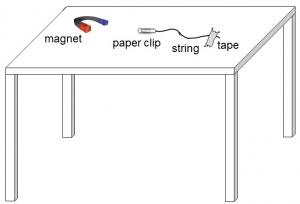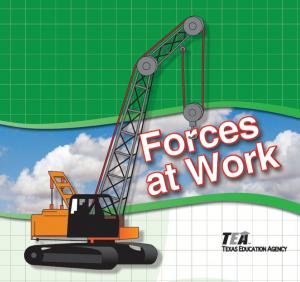Engage: Floating Paper Clip
Can you make a paper clip float in the air without touching it? Have you ever tried?
Gather a 20 cm piece of lightweight string such as thread or yarn, a small paper clip, a magnet, and a strip of tape. Tie one end of the string to the paper clip. Tape the other end of the string to a desk or tabletop. Use the magnet to see if you can make the paper clip float.
What happened when the magnet was close to the paper clip? Did the paper clip move? Did you make it float?
What happened when you moved the magnet away from the paper clip? Why did the paper clip drop? Do you know what force caused that to happen?
Explore: Pushing and Pulling Forces
Click on View Related Items to download and print Explore: Forces at Work. Do each of the activities and place an X in the table if you use a pushing or a pulling force to move the object. Place an X in the table if the force of gravity or magnetism is acting on the object. Leave the "Work" column blank for now.
Which activities involved a pushing force?
Which activities involved a pulling force?
Were the forces of magnetism or gravity acting on any of the objects? How do you know?
Explain: Forces at Work
Click on View Related Items to download and print Explain: Forces at Work Literacy Book. Read the book with a classmate. Stop and discuss each section of the book.
Work through the next activity to process the information in the book.
Go back and review Explore: Forces at Work. Which of those activities involves work? Remember that an object has to be moved, using force, to a new location. If you said rolling a ball, scooting your chair back, feeling magnets repel, dropping a ball, lifting a box, and raising an unopened water bottle all achieve work, you are correct!
Pressing on a wall or your teacher’s desk with your pinkie finger does not involve work. You can press on the wall or desk using all the force you have, but neither object will move to a new location.
Take a minute and explore using a spring scale.
Elaborate: Work Made Easier
Click on the image to begin the online simple machines activity designed by the Museum of Science and Industry in Chicago.
As you go through each task, think about whether forces are involved. If so, what kind of forces? Pushing, pulling, gravity, or magnetism? Think about whether work is being done.
Evaluate: To Work or Not?
Click on View Related Items to download and print Evaluate: Forces at Work Assessment. Work through the questions, answering in complete sentences.
Teacher Notes
Engage
The force of gravity is introduced in third grade. Some students may know about gravity, but some may not as this point in the lesson. Gravity will be defined in the Explain section of the lesson.
Explore
Having materials on hand would be helpful for students to do the Explore activity.
Students will leave the “Work” column blank on Explore: Forces at Work because the concept of work will be defined in the Explain section of the lesson. The “Push” and “Pull” columns focus on the force that causes the objects to move.
Answer Key
Student answers may vary for rolling a ball. If students roll the ball toward themselves, they might consider it a pulling force. If students roll the ball away from themselves, they might consider it a pushing force.
Student answers may vary for raising an unopened water bottle. If students raise an unopened bottle up to their shoulders, it might be considered a pulling force. If students raise the bottle from their shoulders above their heads, it might be considered a pushing force.
If students understand that gravity is a force that pulls everything toward Earth’s surface, they may place an X in every box in the “Pull” column, which is perfectly acceptable.
Explain
The book for this lesson is content heavy. It may be best to read one section at a time and stop often for discussion and reflection. Allow students time to ask questions or discuss the concepts in the book with a classmate.
Magnetism involves repelling (pushing) and attracting (pulling) forces. Items that are attracted to magnets are called magnetic. Examples include some metal items such as iron nails and screws. Items not attracted to magnets are called nonmagnetic. Examples include things made of cloth, rubber, glass, plastic, wood, and some metals like aluminum.
Gravity is a pulling force that keeps everything stuck to Earth’s surface. The more mass an object has, the more gravity pulls. Earth has more gravity than the moon because Earth has more mass than the moon.
Spring scales are introduced in third grade and are used to measure force in newtons (N). Traditional spring scales measure pulling forces. Some spring scales measure both pulling and pushing forces. Spring scales come in different strengths depending on the rigidity of the spring. For less force, scientists use a more sensitive or less rigid spring scale.
Before students begin using spring scales, make sure the scales are calibrated to zero. This can be achieved by sliding a scale or turning a gear or turnstile. Elementary students will use only the newtons scale and ignore the grams scale on a spring scale. Middle school students begin making the connection between force and mass.
The concept of work is defined using two criteria. An object must be moved using force (first criterion) to a new location (second criterion). The definition of work should be kept simple and straightforward in third grade.
In sixth grade, students will calculate work by multiplying force by distance (W = Fd). Work is calculated by how hard and how far you push (or pull) an object. You can exert a great deal of force (pushing on a wall) without doing work if the object to which the force is applied does not move. The force and the motion must be in the same direction (motion is parallel to force). If a door opens and closes, work is not achieved because the door starts and stops in the same location, which means net force is zero.
Third-grade students need to focus only on wheels and axles (wagons, bicycles, cars, wheelbarrows) and pulleys (flag raising) as simple machines. Simple machines make work easier. For example, pulling or pushing a box of bricks across a yard is more difficult than rolling them across a yard in a wagon or wheelbarrow.
Refer back to the activities from Explore. You may need to assist students as they determine which activities accomplished work.
Answer Key
Elaborate
Students can work through all portions of the online interactive, but for the purposes of third grade, they need to focus only on the wheel and axle and pulley.
Students will have the opportunity to experiment and test different tools to accomplish different tasks. As they go through the interactive, students should think about whether forces are involved and whether work is being done.
Evaluate
Students can work independently, in pairs, or in small groups on the assessment. They also could have the option to write the answers or provide the answers to you orally. It may be helpful to provide sentence stems for some students to answer the questions.
Answer Key
Picture A
1. The rope is lifting the box, which means a pulling force is being used.
2. The force of gravity is pulling the box toward Earth’s surface. Magnetism is not affecting the box.
3. Work is being demonstrated because force is being used to move the box from one location to another.
Picture B
1. The boy is using a pushing force to move the skateboard forward.
2. Gravity is pulling the skateboard and the boy toward Earth’s surface. Magnetism is not affecting the skateboard.
3. Work is being demonstrated because force is being used to move the skateboard and boy from one location to another.






